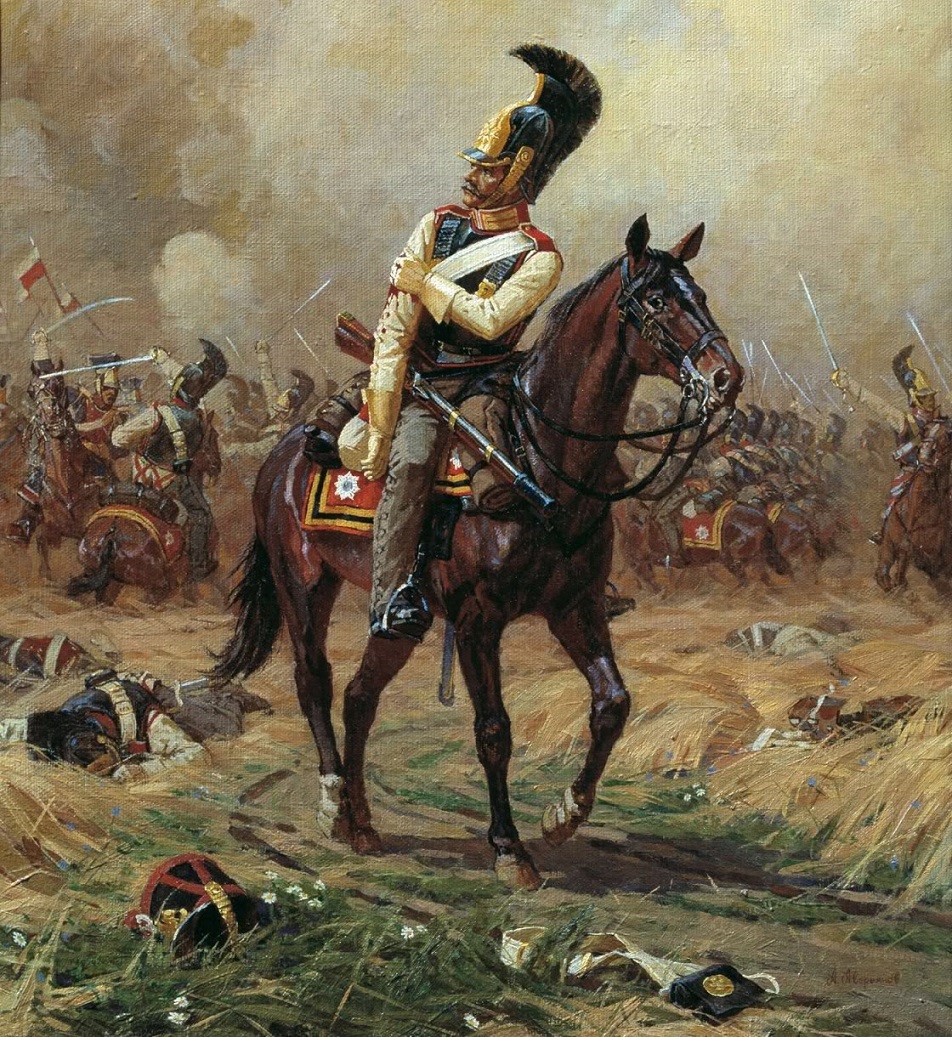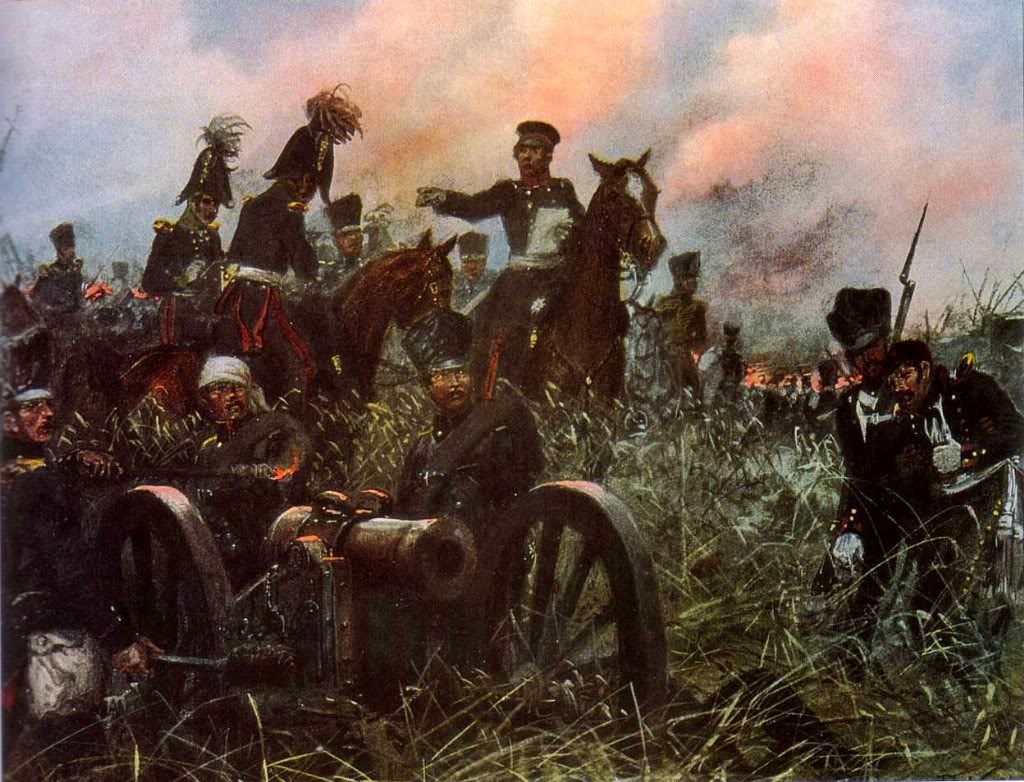 |
| The Battle of Arcole Bridge in 1796 Emile Jean Horacle Vernet (Source) |
Apparently writer's block isn't a new thing with me, or any writer for that matter. Here's a post I did back in 2019, lots of pictures. I like pictures.
Lots of battles, lots of artists, some you may recognize, some you may not. (I was rather sloppy with citing sources back then ...🙄)
 |
| Troopers of the 12th Dragoons Guarding the Emperor Painting by Édouard Detaille |
Enjoy.
 |
| Coronation |
 |
| British 15th Light Dragoons at Sahagún |
 |
| Lasalle, Beau Sabreur |
 |
| Young Bonaparte |
 |
| Marshal Louis-Nicolas Davout The Emperor's Finest Soldier |
 |
| Louis Lepic, Colonel of the Grenadiers à Cheval of the Imperial Guard at Eylau "Heads up! Those are bullets, not turds!" |
 |
| The Polish Charge at Somosierra |
 |
| Wellington at Waterloo, the Emperor's Last Battle |
It was not, not even remotely.






















































Artillery bringing elegance into what would otherwise be a vulgar brawl. A version I heard as a Redleg, before injuries placed me into the Medical Field.
ReplyDeleteI googled it:
“ Artillery adds dignity, to what would otherwise be an ugly brawl. ” — Frederick the Great
As hard as it was to train my horse to allow me to shoot off her, I cannot ponder how much work to train that many horses to go into such black powder stinking brawls.
I'm looking for a great Warrior. Luke Skywalker
Wars not make one great. Yoda.
I like that Frederick the Great quote.
DeleteI can't imagine the training cavalry horses went through.
Well...far as we can trust gulag, I'll go with Frederich der Grosse for the moment. The one close up of artillery in action looked like the cartridge was being loaded backwards; but I had the thought that the powder charge was already down the bore and that was the big-boy version of buck-and-ball, grape followed by a solid shot.
DeleteThe horse training must have been brutal. As ugly as those scenes really were for the men, they must have been horrific for the horses.
Boat Guy
He did say that, I knew that before the Internet was around.
DeleteI think in that artillery close up the round is being inserted backwards. There are other things wrong with that painting as well. (The gunners wouldn't be in full parade kit on the battlefield for one thing.)
The cannon round appears to be on the verge of being rammed home with the shot to the breech and powder to the muzzle. Certainly not the normal way to do things. But, perhaps this illustrates the occasional screw up in the confusion of combat, or pressing an untrained soldier into a new job (yeah, arty crews drilled by the numbers and all should have known how to do this, but...). Or, they did occasionally at very close range fire double canister, or presumably could also fire double round shot. Would the second shot be inserted with shot to the breech? As this is shown as a prepared round, with shot, sabot and powder bag secured together, that may be correct for a double shot firing. Not certain, but maybe Joe will know.
DeleteJohn Blackshow
It looks wrong.
DeleteStruck me that way, but couldn't expect trained artillery men to make such an error, particularly as part of a crew. There are stories of muskets being found on our battlefields during the War Against the States jammed with unfired cartridges.
DeleteDunno, not gonna nitpick further...
Boat Guy
Combat is pretty dang stressful, even the most experienced troops can make mistakes.
DeleteGrape over round shot, perhaps? Like dismantleing shot at sea.
DeletePossible.
DeleteAbout wore my finger out scrolling..... :)
ReplyDeleteSorry about that, I got carried away. It was one of those "Oh, I need to include this one as well ... And this one ... And ..."
DeleteI had a whole folder of battle paintings back then, I think I shared all of them.
Lots of great artwork Sarge. Thanks for sharing.
ReplyDeleteThe one with the Highlander jumping the horse is a sort of amazing thing to keep in a picture. And I cannot imagine into a line of riflemen (or, for that matter, keeping my seat with a Shako on).
Peer pressure, training, getting caught up in the moment, all of those things help to keep a soldier going when the correct response would be to "run like hell!"
DeleteI was thinking about the time it took to paint that first painting before I looked at the rest... there are some serious hours of work spent on capturing the taking of that bridge. Some serious time making all these paintings!
ReplyDeleteI'm sure I had a point when I started typing...
You make a good point. The artists spent hundreds of hours on those paintings.
DeleteIf only Dr. Gatlin had been correct. regards, Alemaster
ReplyDeleteThis one?
Delete"It occurred to me that if I could invent a machine gun which could by its rapidity of fire, enable one man to do as much battle duty as a hundred, that it would, to a large extent supersede the necessity of large armies, and consequently, exposure to battle and disease would be greatly diminished."
YesSir! That one. r/Alemaster
Delete👍
DeleteThe imagination it takes to paint the subject is unbelievable. I'm guessing most of the artists weren't 'there' and only had oral history to go by. Still and all... wow. I didn't see any of the pivotal Texas Revolution in there..... hmmmmm..... Quite an important nation to be overlooked.... But I guess this is "You're A Peein'" in scope today? (I'll take What Continent Do You See In The Morning? for $500)
ReplyDeleteTexas had a little European flavour.... our foe (twice!) was the "Napoleon of the West".
🎶From the halls of Montezuma to the shores of Tennessee!🎶 (I was little the first time I heard the words, and I got them wrong....)
It's all Napoleonic art. As for Santa Anna, Napoléon of the West? Not even close. After all, they called McClellan "Little Napoléon," again hyped and overblown.
DeleteAfter Napoléon's final abdication a number of Imperial Guardsmen tried to set up a community in Texas, there's even a movie about that, can't recall the name. It failed badly.
As to Texas being an "important nation," well, we can talk about that.
Crusty Old TV Tech here. Excellent post. Target-rich commentary environment.
ReplyDeleteI come back to Goya, "La Carga de los Mamelucos", AKA "2nd of May 1808". For some reason that painting of all the ones you have posted speaks of the Napoleonic War era to me most. The folks in Madrid getting attacked by the Mameluks of Pepe Botellas, who resemble the Moors they drove out 300 years prior. The uprising, whatever implements were at hand, attacking the attackers. I can understand that righteous anger. And, I have been near the spot depicted, Calle de Alcala near Puerta del Sol, thanks to Mother AFCC. It was a bit changed in 1984, but still the ghosts of the melee swirled in the Spanish afternoon air.
An excellent painting indeed, Goya didn't pull his punches.
DeleteThe struggle for a bridge can be a key to victory or defeat, and a great event to commit to art. Your leading painting is such a case.
ReplyDeleteThose Europeans have been bashing each other for various, mostly long forgotten, reasons for a VERY Long time.
Archaeologists have done some amazing work trying to understand a battle at a bridge which took place around 1250 BC in the Tollense Valley about 120 km north of Berlin. Hundreds of bodies clustered in a very small area, suggesting more than a thousand fighters, which had to include men from far away as such numbers would have been hard to round up in the extremely sparsely settled area at that time. Lots of weapon inflicted wounds, including flint and bronze arrow or spear heads and blunt force weapons. It must indeed have been a vulgar brawl, with no artillery to lend dignity to it. I am sure Beans would understand the weapons and tactics, even though it predates armor by a few centuries.
John Blackshoe
Do read the story,
https://www.science.org/content/article/slaughter-bridge-uncovering-colossal-bronze-age-battle
Damn!
DeleteA beautiful and sobering gallery of paintings.
ReplyDeleteIt's good that the painter can capture neither the sounds, nor the smells of the land battles.
Especially the smells after several summer days.
Might be better if they could, might make certain folks a bit less bloodthirsty.
DeleteThe painting by Roubaud of the artillery crossing over a bridge of gunner a laying in the ditch, ouch.
ReplyDeleteI have a feeling that actually happened, in Spain I think.
DeleteThat is one helluva one-stop-shop for battle paintings! Not enough depictions of air-power though! Speaking of which, I just just watched Devotion on the plane back from a business trip. Good film, but they conveniently avoided Ens. Brown's strong Christian roots. That actor who played Hudner, and also Hangman in Maverick, probably has a long career ahead of him.
ReplyDeleteVery little in the way of aviation in Napoléon's day. Looks like I should remedy that.
DeleteSome aviation activity in the Franco Prussian war, IIRC.
DeleteJB
Balloons, just like in our war from '61 to '65.
Delete